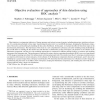Free Online Productivity Tools
i2Speak
i2Symbol
i2OCR
iTex2Img
iWeb2Print
iWeb2Shot
i2Type
iPdf2Split
iPdf2Merge
i2Bopomofo
i2Arabic
i2Style
i2Image
i2PDF
iLatex2Rtf
Sci2ools
CVIU
2007
2007
Objective evaluation of approaches of skin detection using ROC analysis
Skin detection is an important indicator of human presence and actions in many domains, including interaction, interfaces and security. It is commonly performed in three steps: transforming the pixel color to a non-RGB colorspace, dropping the illuminance component of skin color, and classifying by modeling the skin color distribution. In this paper, we evaluate the effect of these three steps on the skin detection performance. The importance of this study is a new comprehensive colorspace and color modeling testing methodology that would allow for making the best choices for skin detection. Combinations of nine colorspaces, the presence or the absence of the illuminance component, and the two color modeling approaches are compared for different settings (indoor or outdoor) and modeling parameters (the histogram size). The performance is measured by using a receiver operating characteristic (ROC) curve on a large dataset of 845 images (consisting more than 18.6 million pixels) with ...
Color | Colorspaces | CVIU 2007 | Skin Detection |
| Added | 13 Dec 2010 |
| Updated | 13 Dec 2010 |
| Type | Journal |
| Year | 2007 |
| Where | CVIU |
| Authors | Stephen Schmugge, Sriram Jayaram, Min C. Shin, Leonid V. Tsap |
Comments (0)

